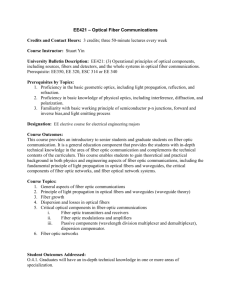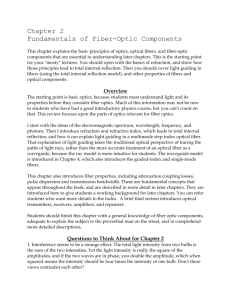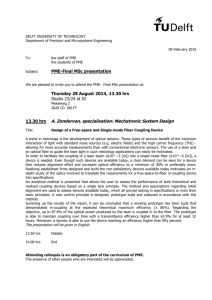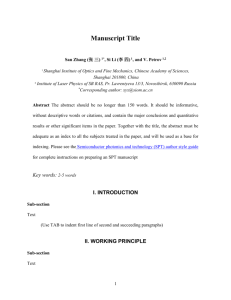Fiber Optics and Optical Sensors
advertisement
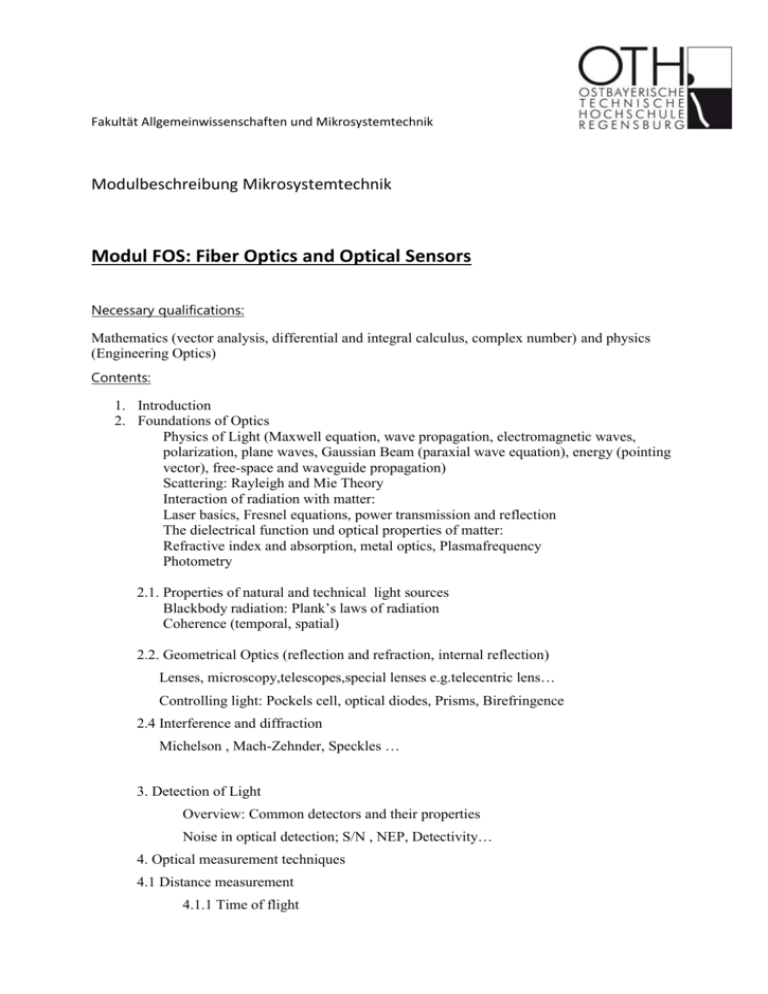
Fakultät Allgemeinwissenschaften und Mikrosystemtechnik Modulbeschreibung Mikrosystemtechnik Modul FOS: Fiber Optics and Optical Sensors Necessary qualifications: Mathematics (vector analysis, differential and integral calculus, complex number) and physics (Engineering Optics) Contents: 1. Introduction 2. Foundations of Optics Physics of Light (Maxwell equation, wave propagation, electromagnetic waves, polarization, plane waves, Gaussian Beam (paraxial wave equation), energy (pointing vector), free-space and waveguide propagation) Scattering: Rayleigh and Mie Theory Interaction of radiation with matter: Laser basics, Fresnel equations, power transmission and reflection The dielectrical function und optical properties of matter: Refractive index and absorption, metal optics, Plasmafrequency Photometry 2.1. Properties of natural and technical light sources Blackbody radiation: Plank’s laws of radiation Coherence (temporal, spatial) 2.2. Geometrical Optics (reflection and refraction, internal reflection) Lenses, microscopy,telescopes,special lenses e.g.telecentric lens… Controlling light: Pockels cell, optical diodes, Prisms, Birefringence 2.4 Interference and diffraction Michelson , Mach-Zehnder, Speckles … 3. Detection of Light Overview: Common detectors and their properties Noise in optical detection; S/N , NEP, Detectivity… 4. Optical measurement techniques 4.1 Distance measurement 4.1.1 Time of flight 4.1.2 Triangulation 4.2.4 Confocal techniques 4.2 Velocity measurement, LDA Laser doppler anemometry 4.3 Meas. surface properties: Profile measurement, roughness measurement 4.4 Ellipsometry, Meas. Layer thickness … 4.5 Interferometry (incl. Speckle interferometry) 4.6 Methods of spectroscopy 4.6.1 IR spectroscopy 4.6.2 Raman, CARS, BOXCARS … 4.7 LIF and LIDAR 5. Image processing methods – basics of Fourier optics 5.1 Dark field and Schlieren fotography Part II: Fiber Optics 6. Optical fiber 6.1. Geometrical-Optics Description (ray optics, step-index fiber, graded-index fibers) 6.2. Fiber Modes (fiber modes of step-index fibers, fiber modes of gradient index fibers, single mode fiber) 6.3. Material Characteristics of fibers (losses, dispersion, mechanical properties of fibers) 6.4. Fiber Manufacturing (design issues, fabrication methods, cables) 7. Signal Degradation in Optical Fibers 7.1. Attenuation (Absorption, scattering losses, bending losses) 7.2. Signal Distortion in Optical Waveguides (Information capacity determination, bandwidth-distance product, group delay, material dispersion, waveguide dispersion, intermodal dispersion) 8. Power Launching and Coupling 8.1. Coupling Loss (phase space, coupling loss of multimode systems, coupling loss of single mode systems) 8.2. Source to Fiber Power Launching (power-coupling calculations, lensing schemes for coupling improvements) 8.3. Fiber optic connectors (ferrule, split-sleeve, assembly of fiber optic connectors, multichannel connectors, insertion loss, return loss, measurement techniques) 9. Alignment Metrology and Techniques 9.1. Alignment Techniques (active automated alignment, hybrid active/passive automated alignment, passive automated alignment) 9.2. Examples of Micro-Optic Based Components ( Coupling radiation from a Laser Diode into a fiber, coupling radiation form a fiber into a photodetector, packaging of optical subassemblies, attenuator, mechanical optical switch, beam splitter.) Learning outcomes: An introduction to modern methods of optical measurement techniques is given. Beginning with the properties of light sources, the propagation of light through media and their properties to the detection of radiation. Special focus is put on distance measurement and surface characterization. The students shall learn to know the physical background and the key areas of fiber optics that are necessary to design fiber optic transmission paths. The students know the technical characteristics of step-index fibers, gradient index fibers and single mode fiber. They are familiar with the meaning and background of the terms waveguide modes, absorption and dispersion. They have acquired knowledge to calculate the coupling loss at interfaces. They have an overview of assembly and packaging techniques. Literature: Axel Donges, Reinhard Noll: „Lasermesstechnik“ , Hüthig, Heidelberg Wolfgang Demtröder: „Laserspektroskopie“, Springer Verlag Jörg Hoffmann: „Handbuch der Messtechnik“ , Hanser A.W.Koch et.al, „Optische Messtechnik an technischen Oberflächen“, Expert Verlag ISBN 3-8169-1372-5 Lasers: A. Yariv: “Optical Electronics”, Saunders College publishing, 1991 J. Hawkes, I. Latimer: “Lasers, Theory and practice”, Prentice Hall, 1995 ISBN 0-13-521493-9 A.E. Siegman: “Lasers”, University Press Oxford, 1986 Optics in common: Eugene Hecht. „Optics“, Addison Wesley, San Francisco, 2002, ISBN 0-8053-8566-5 F.L. Pedrotti, S.J. Leno Pedrotti: “Introduction to optics”, Prentice Hall, New Jersey, 1987, ISBN 0-13-501545-6 K.D. Moeller: “Optics”, University science books, Mill Valley California, 1988, ISBN 0-935702-145-8 Bergmann, Schäfer “Lehrbuch der Experimentalphysik” Band III, Optik, Walter de Gruyter Verlag Max Born And Emil Wolf, "Principles Of Optics", Pergamon Press, Isbn 0-08-018018 3. Fiber Optics Gerd Keiser: Optical Fiber Communications, McGraw-Hill Series in Electrical and Computer Engineering, Singapore, (2000) Handbook of Fiber Optic Data Communication, Elsevier academic press, San Diego (USA) (2002) Joseph C. Palais, Fiber Optic Communication, Prentice Hall, Englewood Cliffs, New Jersey (USA) (1992) Govind P. Agrawal, Fiber-Optic Communication Systems, WILEY INTERSCIENCE, Rochester (USA) (2002) Type of lecture: Lecture supported by blackboard or visualizer and beamer, exercises Duration: 6 semester hours Credits: 6 CP according to ECTS Lecturers: Prof. Dr.-Ing. Gerhard Friedsam, Prof. Dr. rer. nat. Peter Bickel


